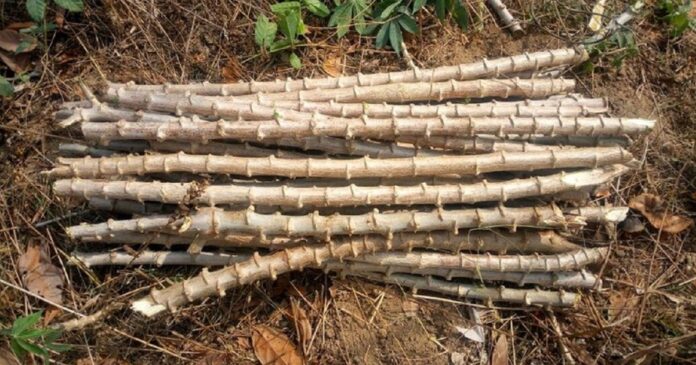The yield of cassava depends on a number of factors including the quality of the cassava planting materials/stem cuttings, cassava variety, soil, weather, cultural practices and others.
Moreover, the quality of cassava planting materials/stem cuttings depends on the age of the stem, thickness, number of nodes per stem cutting and health of the stem cuttings. These factors are necessary for the sprouting of vigorous plants capable of producing a good number of roots and giving good cassava yield.
Read also: Rapid Multiplication of Cassava: Multiply Cassava Sticks in 7 Simple Steps
Let us consider these factors that contribute to the quality of cassava planting materials/stem cuttings necessary for a good yield.
1. The age of the cassava stem
Generally, cuttings from the older, more matured parts of the cassava stem give a better yield than those from the younger portions. Cassava stem cuttings taken from plants more than 18 months old are highly lignified. It also contains only small amounts of food reserves for the shoots.
This affects storage quality, root and shoot formation and development. Also, sprouting buds become less viable. Sprouting delays and the shoots come up with little vigour.
On the other side, cuttings from the young green stem although will sprout, they are extremely susceptible to attack by soil-borne pathogens and sucking insects. Moreover, you cannot store this green immature stems for longer periods. This is because they contain high water content and tend to dehydrate much rapidly.
We recommend that you take your planting materials from plants which are between 8 and 18 months old.
Read also: Detailed Guide to Good Cassava Cultivation
2. The thickness of cassava stem cuttings
You can use any part of the cassava stem as propagating material. However, in a commercial cassava multiplication, you should not use thin stems. They have poor nutrient reserves and it is because the shoots which develop from such stems are weak and only a few, small tuberous roots are produced. As a general rule, we recommend that the thickness of the stems you use for cuttings is not less than 1.5 times the diameter of the thickest part of the stem of the particular variety being used.
Read also: Improved Cassava Varieties in Ghana and Their Characteristics
3. The number of nodes per stem cutting
The nodes of the cassava stem cuttings are where the shoots develop and if you bury them, the roots. You can get a cassava plant from a very small cutting with only one bud. However, the possibilities of sprouting under field conditions are low, especially when soil moisture is limited. Cuttings with 1 – 3 nodes have low percentages of sprouting under field conditions. This is because they are short and so have a lower food reserve and are more susceptible to rapid dehydration and pathogen attack.
Stem cuttings with few buds are more likely to lose their viability of all their buds during propagation, transportation and planting. Theoretically, long cuttings with more than 10 nodes have a better chance of conserving their viability because of the greater number of buds.
Long cuttings give higher yields than short ones. This is because long cuttings have more buried nodes than the short ones and thus produce more stems and leaves, which results in higher yields.
However, the longer the cuttings, the much more propagating material per unit of surface area is required. The recommendation is that cuttings should have five to seven nodes and a minimum length of 20cm.
Read also: Cassava Diseases Prevention and Control to Ensure Food Security
4. The health of stem cutting
Select cassava stems from disease-free plants. You should obtain your planting materials as close as possible to planting time. This is very important to avoid infestation to the cut surfaces of the stem.
It is also very important to avoid rough handling when cutting and transporting the selected stems or branches. The epidermis and buds of cuttings may be bruised or damaged by friction and machete wounds during preparation, transportation, storage and planting. Each wound is a potential site of entry for micro-organisms that may cause rot during storage or after planting.
Make the cut with a well-sharpened machete or circular saw. You may apply fungicide treatment as a protectant when applying insecticide to control the insect pests found on the cuttings. This is not a common practice among cassava farmers but it is highly recommended.
Read also: Catalogue of Agricultural Tools, Implements and Machinery and Their Uses
In summary
For cassava farmers and commercial cassava planting materials producers, the points elaborated are keys to increasing quality and yield in cassava production.
Reference
Cassava in Tropical Africa, A Reference Manual – (IITA)


